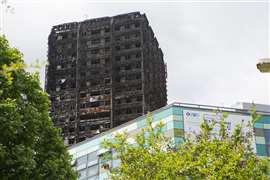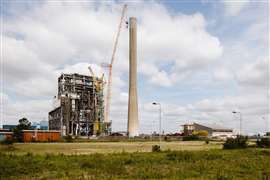Read this article in Français Deutsch Italiano Português Español
Report calls for single construction regulator in England and Wales after deadly Grenfell fire
04 September 2024
 Grenfell Tower in London, UK, after a fire on 14 June 2017 that killed 72 people (Image: Jay via AdobeStock - stock.adobe.com)
Grenfell Tower in London, UK, after a fire on 14 June 2017 that killed 72 people (Image: Jay via AdobeStock - stock.adobe.com)
A single construction regulator should oversee the construction industry in England and Wales.
That is one of the main recommendations to have emerged from a huge 1,700-page, phase 2 report published by the Grenfell Tower Inquiry. The Inquiry was set up after a deadly residential tower block fire in London on 14 June 2017 that killed 72 people.
The phase 2 report seeks to understand how it was possible for so many people to die in a 1970s reinforced concrete building that had been turned into a “death trap” following a refurbishment project completed in 2016 that saw combustible aluminium rain screen cladding and insulation added to it.
The report has taken years to produce, following 312 days of hearings, partially interrupted by the Covid-19 pandemic.
Charting the path to disaster, the report concluded that there had been “decades of failure” by central government and other bodies with responsibility in the construction industry to look at the dangers of incorporating combustible materials into the external walls of high-rise residential buildings (see findings below).
Recommendations
The report found that the regulatory regime for construction in England and Wales at the time of the Grenfell disaster was “too complex and fragmented”. Responsibility for building regulations, product regulations, product testing and building control was spread across a range of different government departments and other bodies.
Among the recommendations the report made relating to the construction industry were:
- The creation of a single construction regulator that should have responsibility for all aspects regulating fire safety in the construction industry. The government would bring together fire safety functions currently exercised by the Ministry for Housing, Communities and Local Government, the Home Office, and the Department for Business and Trade under a single secretary of state.
- A Chief Construction Adviser with a good working knowledge and experience of the construction industry to advise the secretary of state.
- A review of statutory guidance to building regulations and in particular to Approved Document B, which covers requirements under building regulations related to fire safety.
-
New test methods should be developed to test the fire performance of external wall systems.
-
The construction regulator should be responsible for assessing the conformity of construction products with the requirements of legislation, statutory guidance and industry standards and issuing certificates as appropriate.
-
There should be a licensing scheme operated by the construction regulator to be introduced for principal contractors who wish to undertake the construction or refurbishment of higher-risk buildings.
-
The construction regulator should sponsor the development of a construction library with data from tests on products and materials, reports on serious fires similar to the Cladding Materials Library set up by the University of Queensland in Australia.
-
More people from different backgrounds such as academia and those with practical experience of the industry (including fire safety) should be brought in as “fresh minds” to advise on revisions to building regulations.
-
A statutory requirement that a fire safety strategy be produced by a registered fire engineer to be submitted with building control applications for the construction or refurbishment of any higher-risk building.
The report’s recommendations are not legally binding but most organisations involved have pledged to consider them in full.
Findings of the report
Among some of the main findings of the report related to the construction industry were:
- The government missed opportunities to identify the risks posed by the use of combustible cladding panels and insulation, particularly to high-rise buildings between the fire at Knowsley Heights in 1991 and Grenfell in 2017.
- The work of the Building Research Establishment (BRE), which was regarded as a leader in fire safety, was “marred by unprofessional conduct, inadequate practices, a lack of effective oversight, poor reporting and a lack of scientific rigour” from 1991 onwards. It failed to identify important contributory factors to previous fires at Knowsley Heights in 1991, Garnick Court in 1999 and The Edge in 2005.
- There was “systematic dishonesty” among companies who made and sold the rainscreen cladding panels and insulation products used on Grenfell Tower during its refurbishment. The report also found that they engaged in “deliberate and sustained” strategies to manipulate testing of their products. In the case of the main insulation used on Grenfell Tower Celotex RS5000, the BRE was “complicit” in the strategy.
- US-based firm Arconic Architectural Products, which made and sold the Reynobond 55 PE rainscreen cladding panels used on the external wall of Grenfell Tower was aware of serious concern about the safety of aluminium composite (ACM) panels by 2007. It also allowed the continued sale of Reynobond 55 PE in cassette form in the UK (the type used in Grenfell Tower), despite the fact it was aware it performed much worse in a fire than in the alternative riveted form.
- Insulation company Celotex manufactured RS5000, a combustible polyisocyanurate foam used on the tower. In an attempt to break into a market dominated by rival Kingspan it “embarked on a dishonest scheme to mislead customers and the wider market”. It ensured that a cladding system incorporating RS5000 passed BS 8414 tests “with the complicity of BRE”.
- Kingspan “knowingly created a false market” for insulation use on buildings over 18m in height by claiming that its K15 insulation, a small amount of which was used on Grenfell Tower, had been part of a system tested under BS8414 and could be used in the external wall of any building over 18m in height, regardless of its design or other components.
- The companies responsible for the refurbishment of the building, architect Studio E, main contractor Rydon and subcontractor Harley “should have been aware” of the risks of using combustible materials in high-rise buildings. The report stated, “None of those involved in the design of the external wall or the choice of materials acted in accordance with the standards of a reasonably competent person in their position”.
- The procedures of the British Board of Agrément (BBA), a commercial organisation that certifies the compliance of products with the requirements of legislation, were “neither wholly independent nor rigorous”. The BBA issues certificates of compliance in respect of one of the insulation products used on Grenfell Tower, Kingspan K15, and the Reynobond 55 PE panels used as the rainscreen.
- Building control organisation Local Authority Building Control (LABC) “must take its share of the blame” for the market accepting Celotex RS5000 and Kingspan K15 for use on buildings over 18m in height. There was a “complete failure” by LABC to take steps to ensure the certificates it issued in respect of the products were technically accurate.
- The way building safety in England and Wales is managed is “seriously defective”.
- The Tenant Management Organisation in charge of the building and the local council had a “persistent indifference to fire safety”.
To access both an executive summary and the full report itself, click here.
STAY CONNECTED


Receive the information you need when you need it through our world-leading magazines, newsletters and daily briefings.
CONNECT WITH THE TEAM











